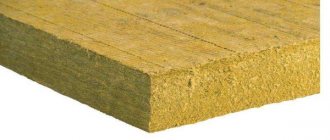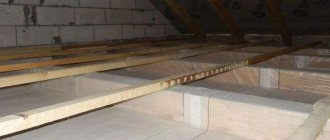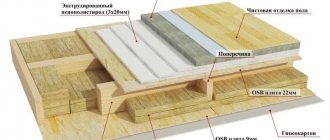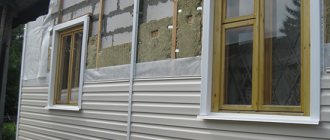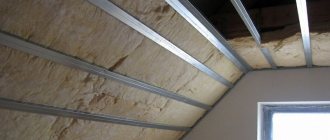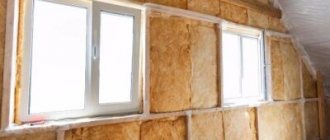Mineral wool
Mineral wool is used not only as insulation, but also as a fire-retardant material. For example, basalt wool is used in places with elevated temperatures, where other thermal insulation, such as polystyrene foam, cannot be installed.
Advantages
Positive qualities of insulation based on mineral wool:
- Long service life;
- Large selection of materials, both in density and thickness;
- Fire resistance;
- Not food for rodents;
- Vapor permeable;
- Do not support the growth of mold and fungi;
- Good sound insulation;
- Low thermal conductivity;
- Easy installation.
Flaws
Although rodents are not interested in mineral wool as food, they can live in it. Also, mineral wool must be protected from the wind, otherwise the fibers and heat will be blown away. Therefore, when insulating walls, it is necessary to install a windproof layer.
Mineral wool in rolls
Mineral wool has a low thermal conductivity coefficient due to the air between the fibers. But if you press it down, the fibers will be compressed, and there will be much less air in them. As a result, thermal conductivity will increase and it will become easier for cold air flows to pass into the room, and for warm ones to escape. Therefore, mineral wool insulation is installed loosely, but at the same time tightly, so that there are no gaps.
When working with mineral wool, you must wear personal protective equipment, as it generates dust. If glass wool dust gets into the respiratory system, skin or eyes, irritation occurs.
Mineral wool must be protected from moisture, especially those based on basalt. If the insulation gets wet, you will have to throw it away, since even after drying, its thermal insulation properties will not return.
Safety
When working with glass wool, its fibers crack and release small particles of glass into the air. They enter the human lungs and exposed parts of the body, which causes tingling and terrible itching. So when working with it, it is better to wear clothes that will cover all parts of the body and at the same time work strictly in a respirator and rubberized gloves.
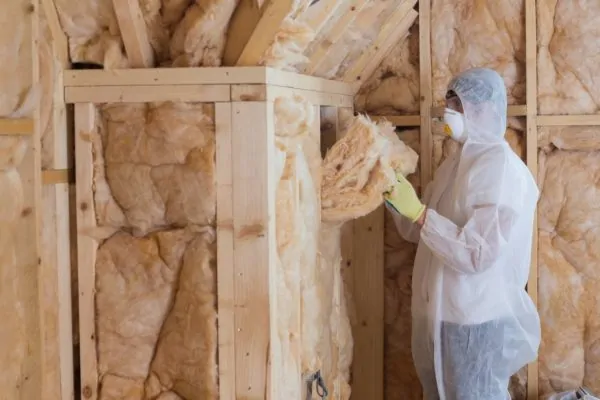
Mineral wool
But working with mineral wool is also not completely safe. During prolonged operation, it begins to emit dust due to the destruction of the material structure. This dust can enter the house and living rooms through cracks and people will breathe it, which can cause a variety of diseases from bronchitis to cancer. Dust can also get into the eyes and lungs of the person working with it. And although it is completely safe in all respects and does not cause any allergic reactions at all, some manufacturers may use lead or even mercury to save money. If mineral wool has been in use for a very long time, it begins to release a toxin - formaldehyde. Formaldehyde, in turn, causes inflammation of the nasopharyngeal mucosa, pneumonia, etc. When working with it, be sure to wear fully covered clothing, a respirator and safety glasses. Do not neglect your safety and the safety of others, and do not forget about safety rules.
Glass wool
Fiberglass insulation is made from broken glass, as well as sand, dolomite, and soda. Compared to basalt wool, glass wool has fibers that are 2 or even 4 times longer, making it stronger and more resilient. Therefore, after pressing, this thermal insulation restores its porosity, even with a minimum material density of 11 kg/m 3.
Advantages
Glass wool insulation has the following positive qualities:
- Resistant to chemicals, do not cause metal corrosion;
- Do not shrink;
- Frost-resistant;
- They have low weight and low hygroscopicity;
- They absorb sound well.
Flaws
At temperatures above the maximum, glass wool loses its elasticity and shape, which is why it is not recommended for use in places with elevated temperatures, such as chimneys. When exposed to constant fire, it burns out.
Staple fiberglass: harmful to skin and eyes
If the process of laying fiberglass was carried out without special clothing and gloves, then sharp particles could get onto the surface of a person’s skin and penetrate inside. This may cause irritation and allergies. Most often, the first signs are itching, redness and pain at the points of penetration. You should not scratch the reddened areas, and first aid consists of rinsing the skin under cold running water.
Everyone knows that glass wool is highly brittle. For this reason, sharp, invisible debris can come into contact with a person's eyes. The work should be performed exclusively with special glasses to prevent further problems.
Among the main symptoms of exposure are the following:
- Sharp, cutting pain in the eyes;
- The appearance of a large stream of tears;
- Discomfort;
- Pain that gets worse.
Taking any independent action in this case is not recommended. If you have at least one of the above signs, you should immediately go to the hospital.
Basalt wool
Basalt thermal insulation is made from gabbro-basalt ore. The maximum temperature that basalt insulation can withstand is +1200°C. There are a large number of sizes, densities and shapes of this insulation.
Advantages
Since basalt wool is made from stone, it is non-flammable. Due to this and the high maximum operating temperature, it is used in places where it is necessary to protect the structure from the effects of high temperatures. For example, basalt is excellent for insulating places where a chimney passes through the attic floor.
Basalt insulation does not shrink and also has excellent vapor permeability. Therefore, it is recommended to use it for wooden structures. In addition, basalt thermal insulation does not absorb water from the air and rodents do not eat it.
Flaws
Basalt insulation cannot be considered environmentally friendly, although it is made from natural components. To improve consumer qualities, chemical additives are added to it, which at high temperatures can release harmful volatile substances.
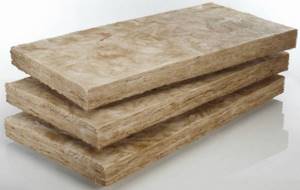
Thermal insulation from gabbro-basalt ore
Rodents are not interested in basalt as food, but they can live in it. As a result, it is necessary to install additional protection against their penetration inside.
Basalt wool does not absorb moisture from the air, but when water hits the surface, it quickly draws it in. Therefore, it cannot be used for insulating foundations, basement floors and blind areas. Also, basalt cannot be considered a good sound insulator, since it only retains airborne noise and allows shock to pass through.
For insulation with low density, wind protection is required, since they are blown. It can also be blown out at the joints, so the slabs must be laid staggered. If it is necessary to lay thermal insulation with a layer of 100 mm, then it is better to do this in 2 layers of 50 mm each.
Basalt insulation does not fit tightly in places where it cannot be positioned at an angle of 90°. Therefore, it is not considered the best option for domes or similar frame structures. When working with basalt wool, you also need to use protective equipment, as it emits dust.
Dependence on the density of the material and the location of insulation
A material with a certain density has a specific purpose. Thus, basalt insulation with a density of 25-30 kg/m 3 is intended for thermal insulation of floors. He should not experience any stress on himself. 35 kg/m3 is used for the roof, 45 kg/m3 can be installed vertically. Materials with a density of 50-60 kg/m 3 are used in layered installation, and 70-80 kg/m 3 are installed in ventilated facades.
For plaster facades it is necessary to purchase slabs with a density of 140-150 kg/m3, and for flat roofs with a load - 160-180 kg/m3.
When choosing a material, you should take into account that the denser the insulation, the higher its price, since more raw materials were spent for production. But at the same time they have the same thermal characteristics.
For thermal insulation of various residential and industrial premises, there are two popular types of thermal insulation materials: glass wool and mineral wool.
If you are going to insulate your house, then it is important to know what the difference is between them, what they are used for, what features and advantages they have. The arguments in favor of choosing the best insulation will be discussed in this article.
Glass wool
During the polymerization process, glass fibers acquire a yellow color. Insulating a house with glass wool is an effective way to protect against drafts and reduce the cost of heating a room. Glass wool is a fibrous insulation material that looks like cotton wool. The main property of glass wool is a high degree of thermal insulation.
The insulation consists of parallel glass fibers made from glass production waste or from the same substances as glass (sand, soda, borax, limestone). Fiberglass is very strong, soft and elastic, and has many air voids between the fibers, which makes it an ideal soundproofing material.
Minvata
The fibrous structure of mineral wool is bonded during the production process using synthetic binders. Mineral wool is an excellent insulating material used to insulate both hot and cold surfaces.
Mineral wool also consists of directed fibers, but it is made from slags of ferrous and non-ferrous metallurgy, silicate materials or molten rocks.
Depending on the type of raw material from which mineral wool is made, it can be stone or slag.
Comparison of insulation materials
Sound insulation of glass wool ceiling The materials differ in the size of the fibers: glass wool has fibers with a thickness of 3-15 microns, and mineral wool - 2-10 microns. The length of glass wool fibers is 2-4 times greater, which provides fiberglass products with greater elasticity and strength.
Glass wool provides better sound insulation due to the attenuation of sound waves in the fibers. However, glass wool undergoes shrinkage over a long period of use. In this indicator, mineral wool wins, which does not change size at all.
Mineral wool is slightly less flammable, but under normal conditions this does not matter, since the temperature limits are very high: 450 for glass wool and 600-700 for mineral wool. The thermal conductivity coefficient of both materials is almost identical.
An important aspect when choosing insulation is the price range. Mineral wool at this point is much more expensive, since the materials for its production have a higher cost and the products are many times larger, which requires additional transportation costs.
Table: Properties of glass wool and stone wool
| Name | Glass wool | Basalt mineral wool |
| The basis | Glass | Basalt |
| Fiber type | Soft and long | Fragile and short |
| Hydrophobicity | Low | High |
| Harm | Acrylic | Phenol |
| Thermal conductivity coefficient (average) | 0.039 W/m*K | 0.040 W/m*K |
| Density | Low | High |
| Temperature Range | -60 to 500 | -190 to 1000 |
Important material characteristics
Glass wool insulation can have different shapes - rolls or slabs. Glass wool is non-flammable, withstands high temperatures, does not smolder, and does not emit harmful substances. Thermal insulation made of glass wool is non-hygroscopic (does not absorb water vapor), has high chemical resistance and a long service life.
Mineral wool is not subject to combustion, rodents do not eat it. Mineral wool in granular form is often used to backfill hollow walls.
Advantages and disadvantages
The advantages of glass wool are as follows:
- light weight;
- high elasticity;
- is pressed for transportation, but perfectly restores its original shape;
- has excellent vapor permeability;
- pronounced water-repellent properties;
- excellent sound and heat insulation;
- does not shrink in structures during long-term use;
- frost resistance.
The disadvantages of working with glass wool include:
- high fragility of the fibers, which provokes the likelihood of small glass fibers getting into the eyes, respiratory tract and skin, which provokes irritation of the mucous membranes and itching of the skin;
- low thermal stability, up to 450 degrees (at higher temperatures the material begins to collapse).
Advantages and disadvantages of mineral wool:
- mineral wool is a coarse-fiber insulation, the production of which uses carbon alloys, thanks to which it is practically not afraid of fire;
- very low degree of shrinkage;
- excellent for both insulating a wooden house from the outside and for insulating walls from the inside;
- simplicity and safety of laying the material.
- over a long period of use, the binder material releases a highly toxic substance - formaldehyde. In this regard, many organizations fighting for the environment refuse to use this material.
Ease of use
*
If we compare which material is more convenient to work with, here again mineral wool takes the lead. When working with mineral wool, there are no problems, unlike glass wool. Mineral wool in the form of slabs can be laid even without the help of specialists and in a very short time. When working with glass wool, it releases small particles of glass and can get into the eyes and open skin, which causes terrible itching. But if you don’t look at the glass particles, it is also quite convenient to work with, because it is very soft and flexible. And when working with slabs, there is even less chance of releasing small glass particles.

Mineral wool
Varieties of mineral wool
- The thickness of the stone wool fibers is from 3 to 5 microns Stone wool. Made from volcanic rocks. Stone wool has excellent thermal conductivity, is not hygroscopic, perfectly repels moisture, provides good sound insulation, is environmentally friendly, the fibers are not scratchy, which is an advantage compared to glass wool. When heated above 700 degrees, it can release phenol, which is used as a binding component. The material is safe under normal operating conditions. It is used for insulating floors, walls, panel structures, and insulating ceilings in a private home.
- Basalt wool is made from a mineral of volcanic origin - basalt. It has good resistance to aggressive chemical environments (heat, frost, humidity), and also has low thermal conductivity. A distinctive feature is tolerance to constant and variable loads and great mechanical endurance.
What is used and in what case
Having considered the main indicators of materials, we can draw the following conclusions:
- Glass wool is quite suitable for insulating dry rooms and building structures that do not receive moisture. Protection from polyethylene film will reduce vapor permeability to zero and the room will become musty.
- Basalt wool can be used in any conditions, even when insulating bathhouses and facades using the “wet” method.
To insulate walls in frame houses and concrete surfaces, it is recommended to lay wool with a density of at least 100 kg/m3. In attics and attics the density should be lower.
